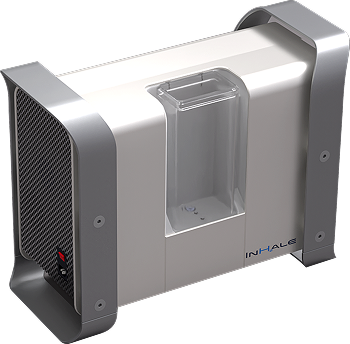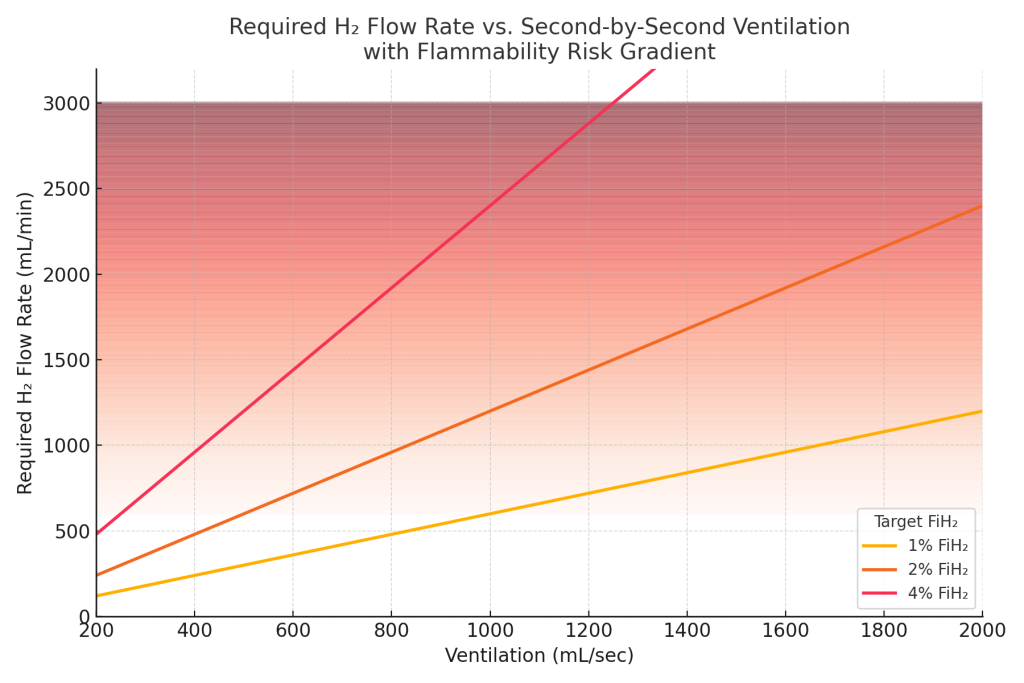
This inhalation system is designed to provide a controlled and consistent fraction of inspired hydrogen (FiH₂) by utilizing an inflatable reservoir bag. The system delivers a total gas flow rate of approximately 10 L/min, ensuring that individuals with a minute ventilation at or below this threshold receive a precise FiH₂ within the selected range (0.5–4% H₂).
Key Functional Features
- Inflatable Reservoir Bag: Ensures that every breath taken contains the intended FiH₂, mitigating variability associated with direct H₂ flow adjustments.
- Adjustable Hydrogen Flow Rate (0.5–4%): Provides precise control over H₂ delivery, accommodating different research parameters and physiological conditions.
- Total Flow Rate of ~10 L/min: Maintains a stable FiH₂ regardless of variations in breathing patterns, tidal volume, or inhalation depth, as long as minute ventilation remains at or below 10 L/min.
- Flammability and Safety Considerations: Hydrogen concentrations exceeding 4.6% in air enter the flammability range, with significantly increased risk above 10%. Most hospitals and clinics will not allow hydrogen inhalation devices exceeding 4% FiH₂ due to safety regulations.
minimum intracellular H₂ concentration of approximately 5–10 µMFiH₂ of at least 1%
- FiH₂ below 1% may not consistently achieve intracellular concentrations necessary for therapeutic effects.
- Higher FiH₂ concentrations (e.g., 2–4%) can more reliably elevate tissue H₂ levels within the therapeutic range.
- Exceeding 4% FiH₂ introduces safety risks, including the potential for hypoxia and, more critically, flammability concerns.
- A direct H₂ flow of 200 mL/min to several liters per minute may be required to achieve an FiH₂ of 4%, depending on individual ventilation rates.
- Flammability risks increase significantly when FiH₂ exceeds 4.6%, with an even greater hazard above 10%.
- Most clinical and research environments prohibit hydrogen inhalation devices exceeding 4% FiH₂ due to these safety concerns.
Regulatory and Clinical Considerations
Most hospitals, clinics, and research institutions follow strict safety guidelines that prohibit hydrogen inhalation systems exceeding 4% FiH₂. This device is designed to comply with these restrictions while providing reliable and reproducible hydrogen delivery.’
Applications
- Preclinical and clinical research on hydrogen therapy.
- Investigations into FiH₂-dependent physiological and biochemical responses.
- Controlled H₂ exposure studies minimizing confounding variables related to respiratory rate and inhalation depth.
Inhale H2 Specification Sheet
- Included Components
- User Manual
- Mask/Hose
- Cannula/Hose/Adapter
- AC Power Cord (list only if cord is 3-pin removable)
- Spare HEPA Filter Cartridge
- Spare Breathing Bags
- General Information
- Model #: TIM-100
- Type: Hydrogen Inhalation Machine
- Hydrogen Production Method: PEM Electrolysis
- Intended Use: Pre-clinical and Cinical Research
- Compliance Standards: UL, CE,
- Features
- Delivers a Non-Flammable Hydrogen Gas Mixture
- Infinite adjustable variability 0.5% to 4% H2 (vol/vol)
- Lightweight & Portable
- Replaceable Supplemental Breathing Bags
- Quiet Operation (< XX db)
- Simple Digital-Dial User Interface
- Built-in Timer Function
- Lightweight Mask or Optional Cannula
- Warranty
- Technical
- Dimensions XXXX L x YYYY H x ZZZZ W
- Weight X lbs / Y kg
- Operating Temperature Range 10 to 40°C
- Storage Conditions: -10 to 50°C, 0–95% RH
- User Interface Digital Display Knob
- Hydrogen Production Electrolytic Cell (SPE-PEM)
- Membrane-Electrode Assembly Pt-Ti, Nafion 117
- Hydrogen Purity 99.995%
- Hydrogen % 0.5% – 4% (adjustable)
- Output Flow Rate Range 8500 to 10,000 mL/min
- Output Pressure 0.1 to 0.5 MPa
- Electrolysis Water Type Distilled
- Electrolysis Water Reservoir Capacity 1 L
- Room-Air Filtration HEPA (user-replaceable cartridge)
- Supplemental Breathing Bag Capacity 3L
- Internal Sensors
- Hydrogen Output % Monitors % H2 in the output air
- Hydrogen Leak Detects an internal H2 leak
- Output-Air Flow Monitors output air flow
- Water Reservoir Level Detects low electrolysis-water level
- Water Reservoir TDS Monitors electrolysis reservoir water TDS
- PEM Temperature Monitors temperature of electrolytic cell
- Water Leak Detects water leak in cabinet
- Tip Detects a cabinet tip over
- Cabinet Ventilation Fan Flow Monitors cabinet ventilation fan flow
- HEPA Filter Installed Detects missing or improperly installed HEPA filter
- Electrical
- AC: 120-240 VAC (50-60HZ); 100 watts
- Power Supply: SMPS

Figure: Required Hydrogen Flow Rate to Achieve Target FiH₂ Across Ventilation Rates, with Flammability Risk Gradient
This figure illustrates the hydrogen gas flow rates (in mL/min) required to achieve target inspired hydrogen concentrations (FiH₂) of 1%, 2%, and 4% across a range of second-by-second ventilation rates (200–2000 mL/sec). Each line represents a fixed FiH₂ target under the assumption that all inspired gas is derived from the hydrogen-air mixture.
The shaded background gradient, beginning at 600 mL/min, represents the relative flammability risk associated with increasing pure H₂ flow rates. The color intensifies as flow rates increase, highlighting the elevated risk when approaching and exceeding thresholds associated with the lower flammability limit (LFL) of hydrogen in ambient air (4.6%). This visual emphasizes the importance of maintaining both concentration and flow within safe and controlled parameters.
Purpose
This platform provides technical information, specifications, and usage rationale for a hydrogen gas inhalation system designed to deliver controlled fractions of inspired hydrogen (FiH₂) for preclinical and clinical research. The goal is to support reproducibility, safety, and translational relevance across diverse experimental models.
System Description
– Reservoir volume: 3 L, capable of accommodating even maximal human tidal volumes
– Hydrogen gas flow rate: Adjustable, depending on desired FiH₂
– Total output flow: ~10 L/min (air + H₂), nearly double the average adult minute ventilation
– H₂ equivalence: Equivalent to ~7.2 L/min of pure hydrogen or ~180 L/min of 4% H₂ mixture*
– Delivery interface: One-way mask, nasal cannula, or enclosed chamber. The one-way mask ensures all inspired air is drawn from the reservoir, maintaining FiH₂ equal to the concentration in the bag
– Recommended use: Inhalation studies in rodents, large animals, cell culture chambers, and human subjects
*In a theoretical example, if an individual were to inhale 3 liters of gas over a 1-second inhalation, achieving a consistent FiH₂ of 4% would require 120 mL of hydrogen to be delivered within that second. This translates to a continuous flow rate of 7.2 L/min of pure H₂. Ensuring a premixed reservoir concentration avoids such real-time delivery demands while maintaining dose accuracy.
This configuration ensures that every breath, regardless of tidal volume, inspiratory duration, or breathing pattern, contains the desired FiH₂. Additionally, hydrogen concentration in the mask, lungs, and during exhalation remains at or below 4%, maintaining operation well within accepted safety margins.
Rationale for Controlled FiH₂ Delivery
Hydrogen gas exerts biological effects only once a threshold concentration is reached within cells and tissues. Based on solubility and diffusion characteristics, this threshold is estimated to correspond to an FiH₂ of approximately ≥1%, yielding intracellular concentrations around 5–10 µM.
Unregulated delivery systems (e.g., direct H₂ flow without air mixing or volume matching) produce highly variable FiH₂ depending on subject ventilation rate, tidal volume, inspiratory time, and breathing frequency. Such variability can lead to under- or over-dosing, poor reproducibility, or unsafe conditions (e.g., oxygen displacement, flammability).
The controlled-reservoir approach facilitates dose-dependent studies in cellular, animal, and human models where concentration-response relationships are a critical experimental variable.
Applications
Rodent and Animal Studies
The inflatable-bag system is compatible with individual cages or sealed exposure chambers. It maintains a uniform, non-flammable H₂ concentration within the air volume, enabling reproducible dosing across animals. This is particularly valuable for:
– Studies on ischemia-reperfusion injury
– Models of inflammation, neurodegeneration, or metabolic dysfunction
– Dose-response investigations using varying FiH₂ concentrations
Cell Culture and In Vitro Applications
By providing controlled FiH₂ environments for gas-permeable cell culture incubators or sealed chambers, this system supports research that is mechanistically aligned with in vivo and clinical applications.
– Enables direct comparison between in vitro and in vivo findings
– Supports mechanistic studies on H₂ signaling pathways
– Avoids hypoxia or hyperoxia effects common in high-H₂ setups
Human Subject Research
The system ensures safe FiH₂ levels below the lower flammability limit (LFL) of hydrogen in air (4.6%). Regulatory bodies and institutional review boards (IRBs) generally permit H₂ inhalation studies using FiH₂ ≤ 4%.
Safety and Compliance Parameters
|
Parameter |
Value/Range |
Notes |
|
Hydrogen concentration (FiH₂) |
0.5% – 4.0% |
Adjustable by flow-mixing ratio |
|
Total gas flow |
~10 L/min |
Matches or exceeds typical minute ventilation to ensure accurate FiH₂ |
|
Flammability threshold (H₂ in air) |
4.6% (lower limit) |
System engineered to remain below LFL |
|
Power requirements |
Inflatable bag: none; system: standard power for electrolysis cell and blower |
Inflatable bag operates passively; active components require external power |
|
Interface options |
One-way mask, nasal cannula, enclosure |
One-way mask ensures all inspired air comes from reservoir to maintain precise FiH₂ |
Supporting Research Standards
This system facilitates adherence to experimental principles such as:
– Reproducibility across trials and subjects
– Dose fidelity and quantification
– Translational alignment between cell, animal, and human models
– Compatibility with institutional safety protocols and IRB guidelines
Downloads and Technical Documentation
– System Specification Sheet (PDF)
– Flow Rate to FiH₂ Conversion Table
– Safety and Flammability Guidelines
– Protocol Templates for Rodent and Cell Studies
– Peer-Reviewed Literature Reference List
Contact
For technical details, academic collaboration, or integration into research protocols, please reach out via email
This device is protected under an active international patent application filed through the World Intellectual Property Organization (WIPO-PCT). The design, technology, and functionality are legally protected across more than 150 countries. Unauthorized copying, replication, or reproduction is strictly prohibited and enforceable under international law.
